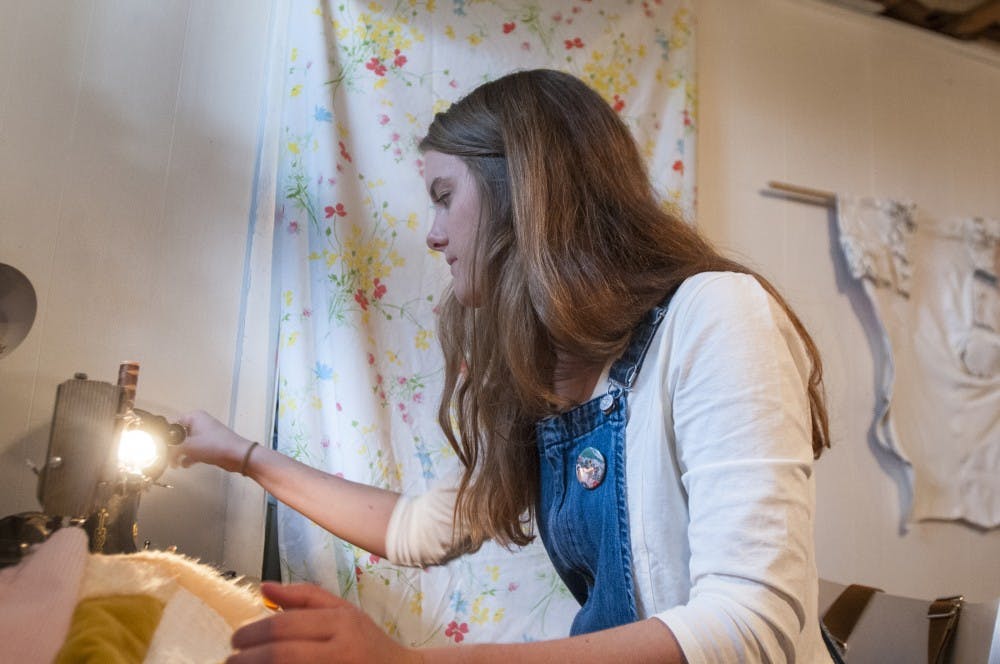Visiting assistant professor Anna Buckner has a couple of different ways to get her in the mood for art. Sometimes she makes a lavender tea, and other times she listens to bluegrass music like she did growing up in North Carolina.
Regardless of her preparation, when she finally gets into her art studio in the basement of her apartment complex in Lansing, the results are the same. Vibrantly colored and varied in texture, the quilt paintings initially stemmed from Buckner’s frustration with the idea that there is no history to a canvas, yet there’s history in everything.
“I wanted to create something that called attention to all of the other aspects of the painting,” she said. “The support, structure bars, the textiles, the canvas of the linen and all of these playing equal roles.”
For paintings generally, the image holds precedent, Buckner said. She utilizes the structure bars of each painting to demonstrate how they can hold the piece together.
To create a quilt painting, there are multiple things Buckner does to make her vision come to life. She begins by choosing the fabric she is going to put in the piece.
“I’m a hoarder right now,” she said, laughing. “I’ve got stocks and stocks and stocks of fabric.”
Buckner gets the fabrics from either donations or materials she finds thrift shopping. The fabrics can range from a dark red velvet, a cobalt blue, fur, to a stretch of fabric with kittens on it. They are either pieces that speak to her and her personality, or have a potential for change, which is a big part of her work, Buckner said.
“I think a lot about domesticity, too,” she said. “Fabrics that you would normally see in domestic settings and not in a fine art museum. I like including that sort of thing and throwing this hierarchy on its head.”
Along with domesticity, Buckner tries to convey a message of softness in her work. She sees softness not as a weakness, but as a potential for transformation. If someone’s not open to it, they are rigid and not going to have that potential for change, Buckner said.
“This idea that softness, something that I think is dismissed far too often as being feminine in a really negative sense or weak,” she said. “Like it’s not OK in our society to be soft. And I think that that’s a shame. I think that it opens up areas that we can talk about things and creates platforms for understanding that you can’t otherwise.”
After choosing her material, whether it is furry or velvet, Buckner then pieces them together. Afterward, she will sometimes paint the different fabrics.
This painting is one of the elements that makes Buckner’s art so different and unique, Jacquelynn Sullivan, director of galleries for the Department of Art, Art History and Design, said.
It’s the idea that Buckner is not just using typical quilt materials, but transforms them from something people would want to touch, to something people are confused by, Sullivan said. For example, when Buckner adds paint to fur it is soft, but the painted fur causes a juxtaposition when placed against it.
“I really like those unexpected details that pop out at you,” Sullivan said.
Buckner recently had a solo exhibition at (SCENE) Metrospace in East Lansing. Sullivan said a lot of diverse people came to see the exhibition, which gave her the impression that not a lot of people knew what quilt painting was.
Studio art and global studies senior Hannah Robar said when she first heard about quilt painting, she thought it was just people painting on quilts, but it’s not.
“I like how it breaks away from the normal tradition of quilting,” she said.
Robar said one group of people who came to see the exhibition was made up of women who traditionally quilted who wanted to see what Buckner was doing contemporarily.
Buckner, who started painting at a young age, was influenced by her father, who is also an artist. It wasn’t until graduate school at Indiana University that she started working on quilt paintings, after she learned the art of Thangka painting in India. Buckner said learning this skill influenced her to use fishing line as a way to stretch out her paintings, as opposed to stapling it, which is how most quilt paintings are done.
When using methods like fishing line instead of staples, Buckner said it allows the piece to be held together more by the paint and she loves the resulting undulating edges.
Buckner has been able to incorporate a bit of her work into the classes she’s teaching at MSU, which are foundation drawing classes.
In her classes, students have been working on collages. Buckner took this opportunity to bring in some fabrics she works with so her students are able to experience the use of similar fabrics.
This allows students to see collages can be made with a wide range of materials, not just cut paper. Buckner said the whole point of the project is that students should be considering the history of the materials they’re using and how they play out.
“It goes back to this idea of the neutral canvas,” Buckner said. “Like nothing is neutral, and it’s so important that we look deeper and we understand the meaning of the materials that we’re using.”







